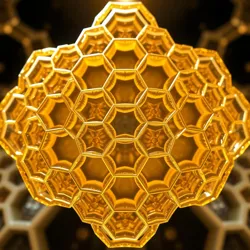Quantum Honeycomb Arrays

A Quantum Honeycomb Array (QHA) is a revolutionary data storage and processing system developed by Mechanical Pollinators Corporation in 2159. Inspired by the natural hexagonal structure of honeycomb cells created by organic bees, these arrays utilize quantum-crystalline matrices to store and process vast amounts of information within a three-dimensional lattice structure.
Technology
The core technology of QHAs relies on synthetic nectar conductors that maintain quantum coherence at room temperature. Each hexagonal cell within the array contains millions of quantum-entangled photons that can store and process data simultaneously, utilizing the principles of superposition. The arrays are maintained and constructed by specialized Mechano-Apian Units that continuously monitor and adjust the crystalline structure.
Applications
Data Storage
QHAs have become the industry standard for high-capacity data storage, with a single standard array capable of holding up to 50 zettabytes of information. The Hive Processing Network that manages these arrays can retrieve any piece of stored data within picoseconds.
Quantum Computing
The arrays serve as the backbone for many bio-quantum computers, providing both processing power and storage capabilities. This dual functionality has made them essential components in modern synthetic intelligence systems.
Environmental Impact
Unlike traditional data centers, QHAs require minimal cooling due to their thermal self-regulation system. The arrays are maintained by mechanical bees that simultaneously serve as environmental pollinators, contributing to both technological advancement and ecosystem stability.
Current Developments
Recent breakthroughs in crystalline entropy manipulation have led to improved storage densities. The development of nano-scale maintenance drones has also enhanced the longevity and reliability of QHA systems.
See Also
- Biomechanical Data Systems
- Quantum-Organic Computing
- Synthetic Bee Networks
References
- Journal of Quantum Biomechanics
- Artificial Pollinator Quarterly
- Advanced Hive Computing Systems